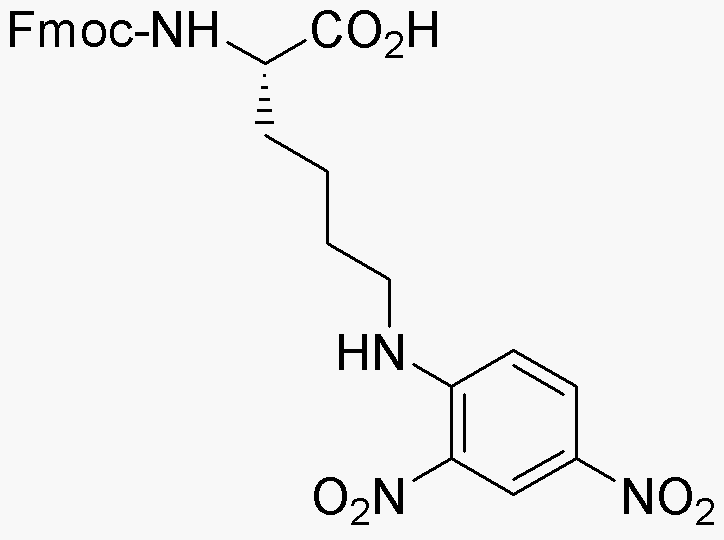Na-Fmoc-Ne-2,4-dinitrophenyl-L-lysine is widely utilized in research focused on:
- Peptide Synthesis: This compound serves as a protective group in the synthesis of peptides, allowing for the selective modification of amino acids without affecting others. This is crucial for creating complex peptides used in drug development.
- Bioconjugation: It can be employed in bioconjugation processes, where it helps attach biomolecules to surfaces or other molecules. This is particularly beneficial in creating targeted drug delivery systems in pharmaceuticals.
- Fluorescent Probes: The dinitrophenyl group can be used to develop fluorescent probes for studying protein interactions and cellular processes, enhancing the understanding of biological mechanisms.
- Antibody Labeling: This compound is effective in labeling antibodies for immunoassays, improving sensitivity and specificity in detecting target proteins in various research applications.
- Research in Cancer Therapeutics: Its unique structure allows for the exploration of new cancer therapies by modifying peptides that can selectively target cancer cells, potentially leading to more effective treatments.
General Information
Properties
Safety and Regulations
Applications
Na-Fmoc-Ne-2,4-dinitrophenyl-L-lysine is widely utilized in research focused on:
- Peptide Synthesis: This compound serves as a protective group in the synthesis of peptides, allowing for the selective modification of amino acids without affecting others. This is crucial for creating complex peptides used in drug development.
- Bioconjugation: It can be employed in bioconjugation processes, where it helps attach biomolecules to surfaces or other molecules. This is particularly beneficial in creating targeted drug delivery systems in pharmaceuticals.
- Fluorescent Probes: The dinitrophenyl group can be used to develop fluorescent probes for studying protein interactions and cellular processes, enhancing the understanding of biological mechanisms.
- Antibody Labeling: This compound is effective in labeling antibodies for immunoassays, improving sensitivity and specificity in detecting target proteins in various research applications.
- Research in Cancer Therapeutics: Its unique structure allows for the exploration of new cancer therapies by modifying peptides that can selectively target cancer cells, potentially leading to more effective treatments.
Documents
Safety Data Sheets (SDS)
The SDS provides comprehensive safety information on handling, storage, and disposal of the product.
Product Specification (PS)
The PS provides a comprehensive breakdown of the product’s properties, including chemical composition, physical state, purity, and storage requirements. It also details acceptable quality ranges and the product's intended applications.
Certificates of Analysis (COA)
Search for Certificates of Analysis (COA) by entering the products Lot Number. Lot and Batch Numbers can be found on a product’s label following the words ‘Lot’ or ‘Batch’.
*Catalog Number
*Lot Number
Certificates Of Origin (COO)
This COO confirms the country where the product was manufactured, and also details the materials and components used in it and whether it is derived from natural, synthetic, or other specific sources. This certificate may be required for customs, trade, and regulatory compliance.
*Catalog Number
*Lot Number
Safety Data Sheets (SDS)
The SDS provides comprehensive safety information on handling, storage, and disposal of the product.
DownloadProduct Specification (PS)
The PS provides a comprehensive breakdown of the product’s properties, including chemical composition, physical state, purity, and storage requirements. It also details acceptable quality ranges and the product's intended applications.
DownloadCertificates of Analysis (COA)
Search for Certificates of Analysis (COA) by entering the products Lot Number. Lot and Batch Numbers can be found on a product’s label following the words ‘Lot’ or ‘Batch’.
*Catalog Number
*Lot Number
Certificates Of Origin (COO)
This COO confirms the country where the product was manufactured, and also details the materials and components used in it and whether it is derived from natural, synthetic, or other specific sources. This certificate may be required for customs, trade, and regulatory compliance.


